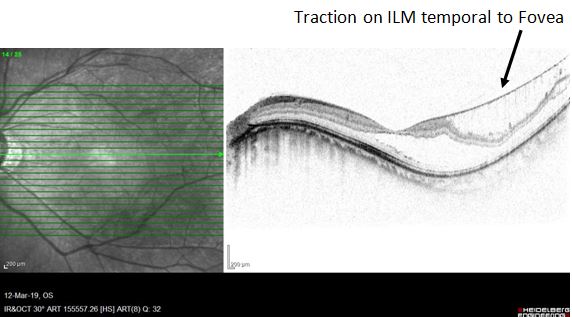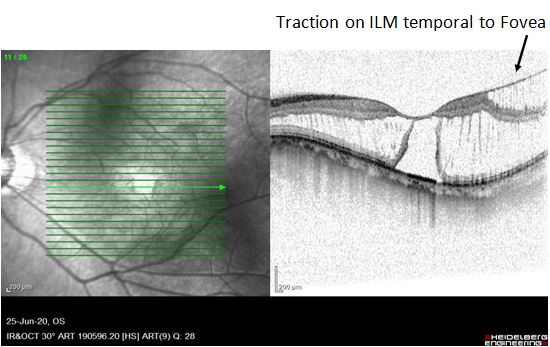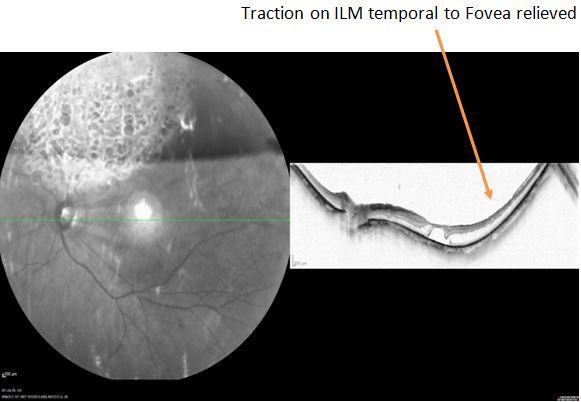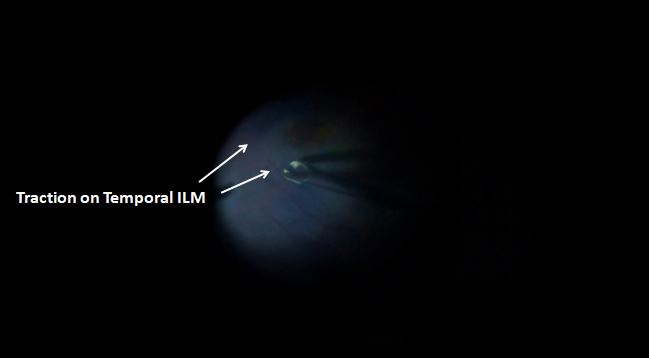[1]
Dolar-Szczasny J, Święch-Zubilewicz A, Mackiewicz J. A Review of Current Myopic Foveoschisis Management Strategies. Seminars in ophthalmology. 2019:34(3):146-156. doi: 10.1080/08820538.2019.1610180. Epub 2019 May 6
[PubMed PMID: 31060414]
[2]
Nebbioso M, Lambiase A, Gharbiya M, Bruscolini A, Alisi L, Bonfiglio V. High myopic patients with and without foveoschisis: morphological and functional characteristics. Documenta ophthalmologica. Advances in ophthalmology. 2020 Dec:141(3):227-236. doi: 10.1007/s10633-020-09767-y. Epub 2020 Apr 22
[PubMed PMID: 32323040]
Level 3 (low-level) evidence
[3]
Takano M, Kishi S. Foveal retinoschisis and retinal detachment in severely myopic eyes with posterior staphyloma. American journal of ophthalmology. 1999 Oct:128(4):472-6
[PubMed PMID: 10577588]
[4]
Lee DH, Moon I, Kang HG, Choi EY, Kim SS, Byeon SH, Koh HJ, Lee SC, Kim M. Surgical outcome and prognostic factors influencing visual acuity in myopic foveoschisis patients. Eye (London, England). 2019 Oct:33(10):1642-1648. doi: 10.1038/s41433-019-0462-7. Epub 2019 May 16
[PubMed PMID: 31097818]
[5]
Frisina R, Baldi A, Cesana BM, Semeraro F, Parolini B. Morphological and clinical characteristics of myopic posterior staphyloma in Caucasians. Graefe's archive for clinical and experimental ophthalmology = Albrecht von Graefes Archiv fur klinische und experimentelle Ophthalmologie. 2016 Nov:254(11):2119-2129
[PubMed PMID: 27106626]
[6]
Zheng F, Wong CW, Sabanayagam C, Cheung YB, Matsumura S, Chua J, Man REK, Ohno-Matsui K, Wong TY, Cheng CY, Tai ES, Lamoureux ELED, Schmetterer L, Kuo A, Hoang QV, Saw SM. Prevalence, risk factors and impact of posterior staphyloma diagnosed from wide-field optical coherence tomography in Singapore adults with high myopia. Acta ophthalmologica. 2021 Mar:99(2):e144-e153. doi: 10.1111/aos.14527. Epub 2020 Jun 29
[PubMed PMID: 32602252]
[7]
Frisina R, Zampedri E, Marchesoni I, Bosio P, Parolini B, Romanelli F. Erratum to: Lamellar macular hole in high myopic eyes with posterior staphyloma: morphological and functional characteristics. Graefe's archive for clinical and experimental ophthalmology = Albrecht von Graefes Archiv fur klinische und experimentelle Ophthalmologie. 2016 Nov:254(11):2289
[PubMed PMID: 27169805]
[8]
dell'Omo R, Virgili G, Bottoni F, Parolini B, De Turris S, Di Salvatore A, dell'Omo E, Costagliola C. Lamellar macular holes in the eyes with pathological myopia. Graefe's archive for clinical and experimental ophthalmology = Albrecht von Graefes Archiv fur klinische und experimentelle Ophthalmologie. 2018 Jul:256(7):1281-1290. doi: 10.1007/s00417-018-3995-8. Epub 2018 May 3
[PubMed PMID: 29725825]
[9]
Leveziel N, Marillet S, Dufour Q, Lichtwitz O, Bentaleb Y, Pelen F, Ingrand P, Bourne R. Prevalence of macular complications related to myopia - Results of a multicenter evaluation of myopic patients in eye clinics in France. Acta ophthalmologica. 2020 Mar:98(2):e245-e251. doi: 10.1111/aos.14246. Epub 2019 Sep 10
[PubMed PMID: 31503418]
[10]
Ren P, Lu L, Tang X, Lu H, Zhao Y, Lou D, Han W. Clinical features of simple hemorrhage and myopic choroidal neovascularization associated with lacquer cracks in pathologic myopia. Graefe's archive for clinical and experimental ophthalmology = Albrecht von Graefes Archiv fur klinische und experimentelle Ophthalmologie. 2020 Dec:258(12):2661-2669. doi: 10.1007/s00417-020-04778-6. Epub 2020 Jul 9
[PubMed PMID: 32648154]
[11]
Guo X, Chen X, Li M, Li S, You R, Wang Y. Association between morphological characteristics of the optic disc and other anatomical features of the fundus in highly myopic eyes. European journal of ophthalmology. 2021 Sep:31(5):2329-2338. doi: 10.1177/1120672120945901. Epub 2020 Aug 5
[PubMed PMID: 32757632]
[12]
Pugazhendhi S, Ambati B, Hunter AA. Pathogenesis and Prevention of Worsening Axial Elongation in Pathological Myopia. Clinical ophthalmology (Auckland, N.Z.). 2020:14():853-873. doi: 10.2147/OPTH.S241435. Epub 2020 Mar 18
[PubMed PMID: 32256044]
[13]
Rino F, Elena Z, Ivan M, Paolo B, Barbara P, Federica R. Lamellar macular hole in high myopic eyes with posterior staphyloma: morphological and functional characteristics. Graefe's archive for clinical and experimental ophthalmology = Albrecht von Graefes Archiv fur klinische und experimentelle Ophthalmologie. 2016 Nov:254(11):2141-2150
[PubMed PMID: 27122245]
[14]
Ono T, Terada Y, Mori Y, Kataoka Y, Nakahara M, Miyata K. Spontaneous resolution of myopic foveoschisis and a macular hole with retinal detachment. American journal of ophthalmology case reports. 2019 Mar:13():143-146. doi: 10.1016/j.ajoc.2019.01.002. Epub 2019 Jan 9
[PubMed PMID: 30705999]
Level 3 (low-level) evidence
[15]
Xie ZG, He QY, Zhu J, Du W, Tong J, Chen F. A Modified Surgical Technique of Fovea-Sparing Internal Limiting Membrane Peeling: Continuous Arc-Shaped Foldback Peeling. Journal of ophthalmology. 2020:2020():3568938. doi: 10.1155/2020/3568938. Epub 2020 Mar 23
[PubMed PMID: 32280519]
[16]
Vogt D, Stefanov S, Guenther SR, Hagenau F, Wolf A, Priglinger SG, Schumann RG. Comparison of Vitreomacular Interface Changes in Myopic Foveoschisis and Idiopathic Epiretinal Membrane Foveoschisis. American journal of ophthalmology. 2020 Sep:217():152-161. doi: 10.1016/j.ajo.2020.04.023. Epub 2020 Apr 29
[PubMed PMID: 32360335]
[17]
Al-Dhibi H, Chaudhry IA, Al-Assiri A, Shamsi FA. Development of early choroidal neovascular membrane in a young myope after LASIK. European journal of ophthalmology. 2007 Mar-Apr:17(2):262-5
[PubMed PMID: 17415702]
[18]
Lee GW, Kim JH, Kang SW, Kim J. Structural profile of dome-shaped macula in degenerative myopia and its association with macular disorders. BMC ophthalmology. 2020 May 24:20(1):202. doi: 10.1186/s12886-020-01473-2. Epub 2020 May 24
[PubMed PMID: 32448138]
[19]
Sborgia G, Boscia F, Niro A, Giancipoli E, D'Amico Ricci G, Sborgia A, Sborgia L, Recchimurzo N, Romano MR, Addabbo G, Alessio G. Morphologic and functional outcomes of different optical coherence tomography patterns of myopic foveoschisis after vitrectomy and inner limiting membrane peeling. Eye (London, England). 2019 Nov:33(11):1768-1775. doi: 10.1038/s41433-019-0490-3. Epub 2019 Jun 17
[PubMed PMID: 31209260]
[20]
AttaAllah HR, Omar IAN, Abdelhalim AS. Assessment of Posterior Segment Using Spectral Domain OCT in Highly Myopic Eyes. The open ophthalmology journal. 2017:11():334-345. doi: 10.2174/1874364101711010334. Epub 2017 Nov 22
[PubMed PMID: 29299081]
[21]
Gui J, Ai L, Huang T. Vitrectomy with or without internal limiting membrane peeling for myopic foveoschisis. BMC ophthalmology. 2020 Mar 4:20(1):83. doi: 10.1186/s12886-020-01354-8. Epub 2020 Mar 4
[PubMed PMID: 32131776]
[22]
Grewal PS, Seamone M, Greve M, Deveau A, Gupta RR. INTERNAL CHANDELIER-ASSISTED MACULAR BUCKLING FOR MYOPIC FOVEOSCHISIS. Retinal cases & brief reports. 2022 Jul 1:16(4):532-535. doi: 10.1097/ICB.0000000000001024. Epub
[PubMed PMID: 32541430]
Level 3 (low-level) evidence
[23]
Zhao X, Ma W, Lian P, Tanumiharjo S, Lin Y, Ding X, Stewart JM, Liu B, Lu L. Three-year outcomes of macular buckling for macular holes and foveoschisis in highly myopic eyes. Acta ophthalmologica. 2020 Jun:98(4):e470-e478. doi: 10.1111/aos.14305. Epub 2019 Nov 19
[PubMed PMID: 31742899]
[24]
Parolini B, Frisina R, Pinackatt S, Gasparotti R, Gatti E, Baldi A, Penzani R, Lucente A, Semeraro F. INDICATIONS AND RESULTS OF A NEW L-SHAPED MACULAR BUCKLE TO SUPPORT A POSTERIOR STAPHYLOMA IN HIGH MYOPIA. Retina (Philadelphia, Pa.). 2015 Dec:35(12):2469-82. doi: 10.1097/IAE.0000000000000613. Epub
[PubMed PMID: 26079474]
[25]
Parolini B, Frisina R, Pinackatt S, Mete M. A new L-shaped design of macular buckle to support a posterior staphyloma in high myopia. Retina (Philadelphia, Pa.). 2013 Jul-Aug:33(7):1466-70. doi: 10.1097/IAE.0b013e31828e69ea. Epub
[PubMed PMID: 23619638]
[26]
Wang JL, Wang YL. Long-Term Outcome of Vitrectomy with Suitable Internal Limiting Membrane Peeling and Air Tamponade for Highly Myopic Foveoschisis-Associated Lamellar Macular Hole. Journal of ophthalmology. 2020:2020():2074037. doi: 10.1155/2020/2074037. Epub 2020 Feb 21
[PubMed PMID: 32148935]
[27]
Alkabes M, Mateo C. Macular buckle technique in myopic traction maculopathy: a 16-year review of the literature and a comparison with vitreous surgery. Graefe's archive for clinical and experimental ophthalmology = Albrecht von Graefes Archiv fur klinische und experimentelle Ophthalmologie. 2018 May:256(5):863-877. doi: 10.1007/s00417-018-3947-3. Epub 2018 Mar 28
[PubMed PMID: 29589106]
[28]
Parolini B, Palmieri M, Finzi A, Besozzi G, Lucente A, Nava U, Pinackatt S, Adelman R, Frisina R. The new Myopic Traction Maculopathy Staging System. European journal of ophthalmology. 2021 May:31(3):1299-1312. doi: 10.1177/1120672120930590. Epub 2020 Jun 8
[PubMed PMID: 32506945]
[29]
Kim CY, Kim MS, Kim KL, Woo SJ, Park KH. Prognostic Factors Related with Surgical Outcome of Vitrectomy in Myopic Traction Maculopathy. Korean journal of ophthalmology : KJO. 2020 Feb:34(1):67-75. doi: 10.3341/kjo.2019.0115. Epub
[PubMed PMID: 32037751]
[30]
Gaucher D, Haouchine B, Tadayoni R, Massin P, Erginay A, Benhamou N, Gaudric A. Long-term follow-up of high myopic foveoschisis: natural course and surgical outcome. American journal of ophthalmology. 2007 Mar:143(3):455-62
[PubMed PMID: 17222382]
[31]
Gohil R, Sivaprasad S, Han LT, Mathew R, Kiousis G, Yang Y. Myopic foveoschisis: a clinical review. Eye (London, England). 2015 May:29(5):593-601. doi: 10.1038/eye.2014.311. Epub 2015 Mar 6
[PubMed PMID: 25744445]




